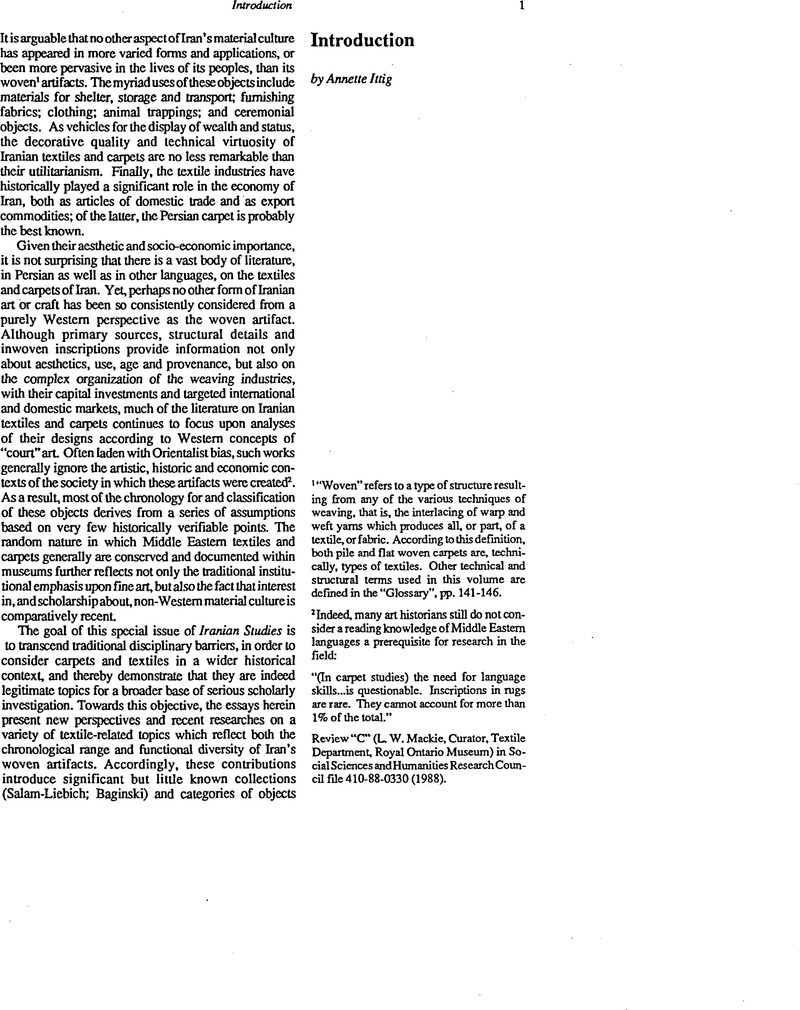No CrossRef data available.
Article contents
Abstract

- Type
- Introduction
- Information
- Iranian Studies , Volume 25 , Issue 1-2: The Carpets and Textiles of Iran: New Perspectives in Research , 1992 , pp. 1 - 6
- Copyright
- Copyright © Association For Iranian Studies, Inc 1992
References
1 “Woven” refers to a type of structure resulting from any of the various techniques of weaving, that is, the interlacing of warp and weft yams which produces all, or part, of a textile, or fabric. According to this definition, both pile and flat woven carpets are, technically, types of textiles. Other technical and structural terms used in this volume are defined in the “Glossary”, pp. 141-146.
2 Indeed, many art historians still do not consider a reading knowledge of Middle Eastern languages a prerequisite for research in the field: “(In carpet studies) the need for language skills …is questionable. Inscriptions in rugs are rare. They cannot account for more than 1% of the total.“ Review “C” (L. W. Mackie, Curator, Textile Department, Royal Ontario Museum) in Social Sciences and Humanities Research Council file 410-88-0330 (1988).
3 Metropolitan Museum of Art, H. Dunscombe Colt Gift, inv. no. 69.2434a,b. The structure of these fragments is weft-faced plain weave with supplementary looped pile. The earliest well-preserved example of knotted pile is the Pazyryk carpet, which is dated to the end of the fourth century B.C. or the beginning of the third century B.C., and which has often been attributed to Achaemenid manufacture. However, the origins of the Pazyryk remain controversial; for alternative attributions, see Rubinson, K.S., “Carpets VI. Pre-Islamic Carpets”, Encyclopedia Iranica, vol.IV, fasc. 8 (1990), p.859Google Scholar; H. Bohmer and J. Thompson, “The Pazyryk Carpet: A Technical Discussion”, SOURCE. Notes in the History of Art, vol. X, no. 4 (Summer, 1991), pp. 30-36.Google Scholar
4 Barber, E.J.W, Prehistoric Textiles. The Development of Cloth in the Neolithic and Bronze Ages with Special Reference to the Agean (Princeton, 1991), pp. xxii; 70.Google Scholar
5 For a recent summary of Safavid carpet production, see Walker, D. “Carpets IX. Safavid Period”, Encyclopedia Iranica, vol. IV, fasc. 8 (1990), pp. 866-875Google Scholar.
6 For opposing views on the authenticity of the Rayy silks, see Shepherd, D., “Medieval Persian Silks in Fact and Fancy”, Bulletin de liaison du CIETA, nos. 3940 (1974), pp. 1- 135Google Scholar and the 1973 Riggisberg Report in issue no. 37 of the same journal.
7 Scholars concur that J. Lessing's Orientalische Teppichmuster nach Bildern und Originalen des XV bis XVI Jahrhunderts (Berlin, 1877) initiated art historical research on the Oriental carpet. Through the presentation of carpet patterns in medieval European paintings Lessing's objective was to provide the designers of contemporary carpets with “classical” models; he maintained that the finest carpet designs were produced during the fifteenth and sixteenth centuries, and that they deteriorated thereafter. Later art historical publications have continued to assess Persian carpets by these same criteria; for a summary of the literature on post-Safavid carpets, see Ittig, A., ‘The Persian Carpet: Previous Studies and Future Directions”, Oriental Rug Review, vol. IV, no. 7 (Oct. 1984), pp. 2-4.Google Scholar
8 For example,
”…let me point out the nature of the Canadian (museum) rug holdings. Probably 99% of the rugs (roughly 2475 out of 2500) were woven during the last 125 years and most during the last 88 years. It would be a welcome surprise if there are more than 25 rugs that qualify as classical rugs, those woven during the 15th through early 18th centuries. It is the classical rugs that art historians study, not the late 19th and 20th century rugs.“
Review “C” (L. W. Mackie), op. cit.
9 Emery, I., The Primary Structures of Fabrics (Washington, D.C., 1966).Google Scholar
10 Burnham, D.K., Warp and Weft. A Textile Terminology (Toronto, 1980).Google Scholar
11 See, for example, Dal Farra, M., “A ‘Safavid Cadabi” in the Royal Ontario Museum Reconsidered”, pp. 81-90.CrossRefGoogle Scholar
12 In this respect, the pioneering work by N. A. Reath and Sachs, E. B., Persian Textiles and their Techniques from the Sixth to the Eighteenth Centuries, including a System for General Textile Classification (New Haven, 1937)Google Scholar is still the most comprehensive.




